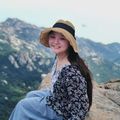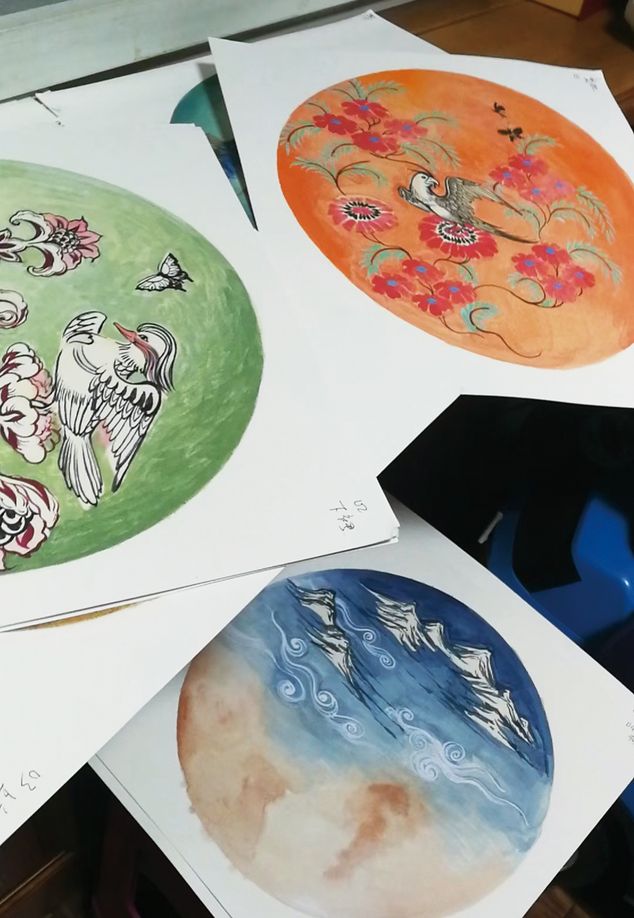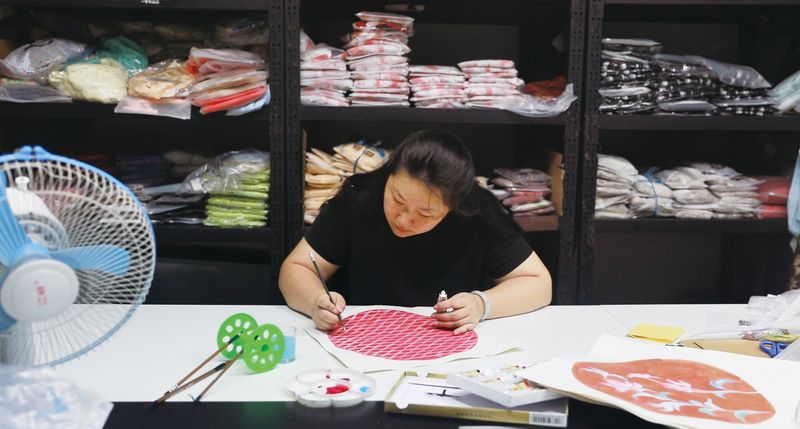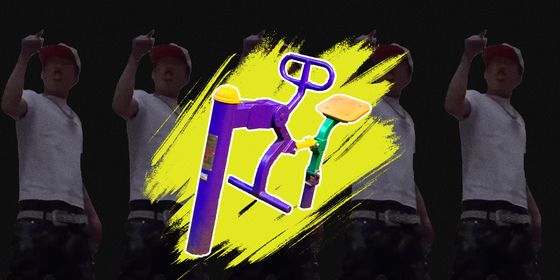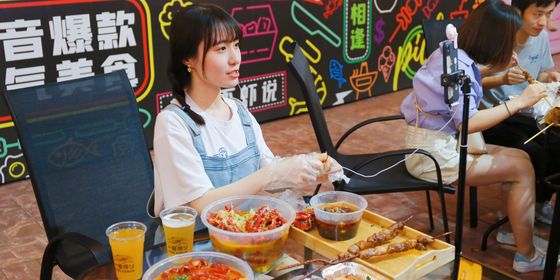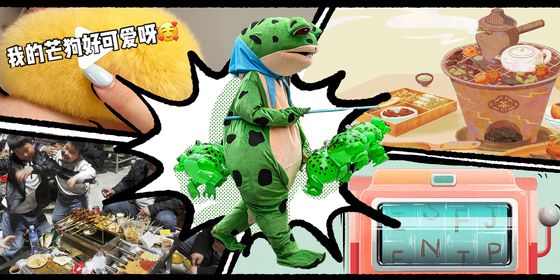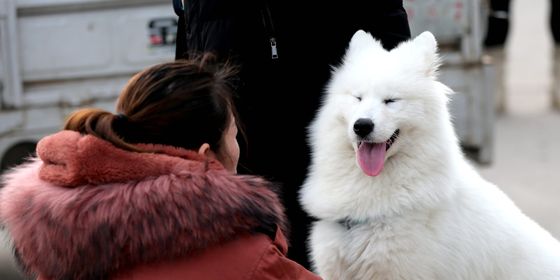Fashion influencer Ao Luojia talks about internet fame and updating traditional “hanfu” for modern tastes
The court lady sports a round face and plump figure under her ruqun, a short jacket tucked under a long wrap-skirt. She has knotted hair in a tall pompadour, painted her lips the shape and color of a ripe cherry, and drawn red flower petals between her brows, as if a plum blossom has fallen on her forehead as she slept.
This is no painting from the Tang dynasty (618 – 907), though—it’s a photo album that went viral online during the Lunar New Year of 2018. In the most famous photos of the collection, the lady is chuckling greedily at a bowl of tangyuan, a dessert made of glutinous rice balls with sweet filling, combining ancient aesthetics with modern humor.
The project is the brainchild of fashion designer Zheng Qi, who served as the artistic director as well as the model in the photos. A native of Chongqing, Zheng, who goes by the professional name Ao Luojia, studied fashion design at Chongqing Textile Workers University (now part of Chongqing Normal University). After working as an illustration artist and running a store that sells a multitude of handcraft including dolls, leathercraft, and pottery, she became drawn to hanfu, a generic term referring to the traditional clothes of China’s majority Han people, which has been experiencing a revival from a small group of dedicated fashion history enthusiasts since the early 2000s.
After opening her own online hanfu shop in 2013, Zheng accidentally became an influencer within China’s hanfu community due to her photo shoot, which also earned her the nickname “Sister Tangyuan.” In the makeshift studio where her teammates in XL Girls Have a Brilliant Future, a reality show featuring plus-sized women in a business competition, are getting their hair done, Zheng takes a break and talks to TWOC about her unexpected rise to fame and her vision for hanfu’s future.
What made you decide to study fashion design at university?
It was the program with the lowest tuition, although later I realized I had been duped, because fabrics are very expensive.
How did you start your career in making hanfu?
At first hanfu was just a concept to me. I have a friend who draws cartoons inspired by classical Chinese art, and one day she asked me, “Would you feel comfortable wearing hanfu on the streets?” I thought about it and said yes. But neither of us knew where we could find hanfu. Later, when I was running a handcraft shop, I met a group of young people who liked to wear hanfu. I thought they were so cute and started to join them, first just as an observer. For example, when they gathered together for festivals, I would sponsor them with some free gifts, like a dozen trinkets. When my shop closed, I had more free time and started to help these friends make base layers that go with hanfu. That’s how I started my career.
What was the story behind the portrait series that went viral?
My business went into a two-year hiatus because I became a mother. By the time I came back after having a baby, the hanfu market was already saturated, and it was difficult for me to find a place in it. I tried different strategies, like making hanfu for children or modernized hanfu. Then, when I was looking for clothes that I could wear, I realized the market for plus-size clothing looked promising, so I wanted to make plus-size hanfu. All my friends were against it. They thought it was too niche, and a small company like mine didn’t have enough resources to market a product like this. But I am a woman of actions. When everyone disapproved of my idea, I had already found a photographer and made a sample. I thought I’d just keep the portraits as a souvenir from when I was at the heaviest point of my life. Who knew I’d end up reaching such heights?
I never expected to go viral. The portraits were so adorable that I myself was impressed. I was happy and just wanted to share them online. I had no idea they would be so popular.
Did becoming an internet celebrity change your life and career?
It was quite a roller-coaster. The hanfu circle celebrated me; they thought, finally there is an influencer among us. But for a long time, I felt like an imposter, that I had stolen something that didn’t belong to me. For decades, a lot of people in the industry worked hard to research and promote hanfu, and they are all better than me in terms of quantity or quality, but I was the one who went viral. I didn’t think I deserved all the attention. Then my friends told me: “If you really believe you don’t deserve it, you can work hard to get there.”
And most people now associate me with the type of hanfu that replicates a certain style from ancient China, like in the portrait series. But in fact, before that, I experimented a lot with modernized hanfu. When we talk about hanfu today, we talk about it as a fashion choice that’s out of the ordinary, as part of a culture that was disrupted but is now being revived. But I want to work off a hypothesis—if hanfu culture hadn’t been disrupted in history, what could it have evolved into today? I have more interest in exploring that possibility and have done a lot of research in it.
Still, against my intention, I have been pushed to the position of being a champion of traditional hanfu, and I don’t have as big a voice in modernized hanfu, so right now I am focusing on researching clothes from the period centered around the Tang dynasty and replicating dresses from paintings with a systematic approach. It’s also something I enjoy and a breakthrough point in my career. I think both are important. On the one hand, we need to research traditional and original hanfu and understand its history; on the other hand, we need to experiment, innovate, and create styles that reflect our time.
We usually think of hanfu as the traditional outfit of the Han before Manchu fashion took over at the beginning of the Qing dynasty. What would modernized hanfu look like?
It’s very different from most of what we see today. It keeps the basic structure of hanfu, but the fabrics and colors are different, and the contrast is more intense. It is still a round-collar robe, but the way you wear it and the signal it sends are different.
And how do you conduct research in order to design a dress that replicates ancient styles?
First, I find a theme and decide what I want to make. Then, the easy way is to consult a friend who makes similar clothes. The more difficult way is to do archival research or find images online. Or working really hard, I would visit museums or consult scholars. I do all three.
Scholars have a lot of knowledge and authority, but there is one shortcoming, which is that most of their research is focused on one specific area. For example, a scholar who researches cloud-pattern brocade does only that.
But hanfu enthusiasts often like to combine things. For example, women’s shawls in the Tang dynasty give a feeling of floating in the air. In the following Song dynasty, they started to drape at the front, not at the back. Gradually, when it came to the Yuan (1206 – 1368) or Ming (1368 – 1644) dynasty, decorations at the shoulders had moved to the lower part of the body. I would synthesize all the different textures, fabrics, and styles from different periods and regions. When hanfu enthusiasts are designing a piece of clothing, we usually visit a lot of scholars and consult a lot of historical documents.
How has the hanfu industry changed since you first entered it?
Hanfu is a bottom-up cultural movement. I actually see it as China’s version of the Renaissance, but way before it was mature, the invasion of capital and overexposure by the media had turned it into a bubble. Now, everyone is thinking about copying after popular styles or starting a price war. Today I’ll buy a piece at 99 RMB. The next day it’s 55 RMB, so I will buy another. It’s becoming a form of fast consumption for young people, which cannot sustain the research and efforts needed in making good hanfu.
If you want hanfu to become part of daily life, then why is it bad that it’s becoming a commodity?
Right now a lot of people wear hanfu just for attention and treat it as a pretty piece of clothing, but its cultural significance has faded. We hope modernized hanfu will become a set of clothing that all Chinese or Chinese diaspora will own, something that people wear to important occasions, something that has cultural texture and roots in history and is different from clothing from other cultures. If you just see hanfu as a pretty little dress, when the fad is over, the dress will also be gone.
Viral Revival: Making Traditional Clothing Cool Again is a story from our issue, “Access Wanted.” To read the entire issue, become a subscriber and receive the full magazine.






